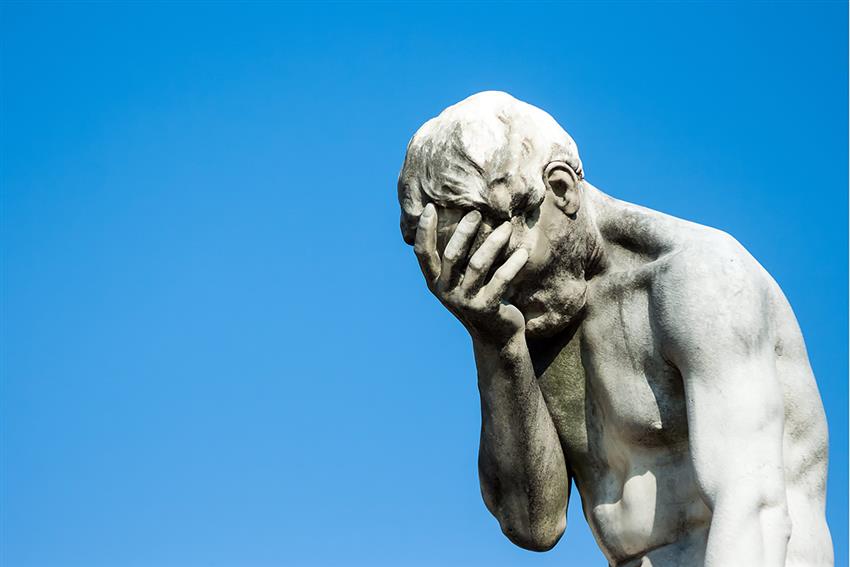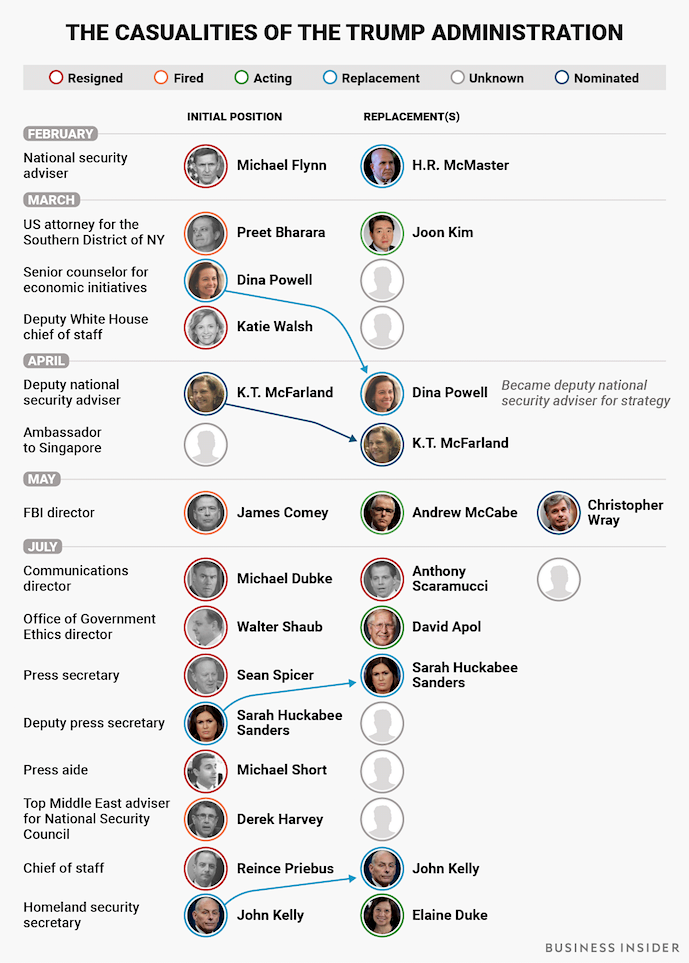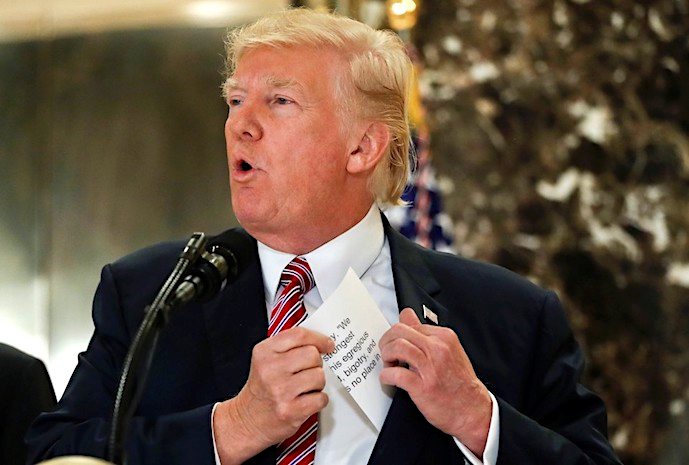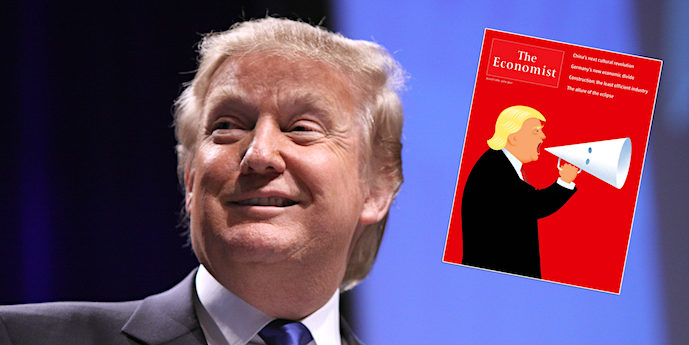
Just when we thought Trump couldn’t possibly get worse, he has. Almost every day he exhibits more grotesque behaviour. It astonishes his colleagues, the media, the US electorate, world leaders, and indeed the entire world.
Back in May
The Political Sword published
America – what have you done?, which described the contemporary chaotic scene in the White House: That was at the time of Trump’s discussion with Russian foreign minister Sergei Lavrov in the Oval Office, during which he foolishly exchanged vital intelligence with him. Trump subsequently denied this but later admitted that it had occurred, excusing his mistake on the grounds that he was entitled to do so!
America – what have you done? was published around the time that Trump fired FBI chief James Comey. The story behind this changed by the day. It emerged that Trump had tried to get Comey to wind up the investigation into former national security adviser Michael Flynn who had resigned after being confronted with the fact that he had misled Vice President Mike Pence about his contacts with Russian officials before Trump took office. Trump maligned Comey viciously, calling him incompetent, a ‘grandstander’ and a ‘showboat’. He said he was ‘crazy, a real nut job’, extraordinary language from the President of the United States.
Next, gaffe-prone White House Press Secretary Sean Spicer was fired and replaced with the sycophantic Sarah Huckabee Sanders. Spicer was fired because he had objected strongly to the appointment of ex-hedge fund manager Anthony Scaramucci as White House Communications Director to whom Spicer was to be subservient.
Then Trump fired Reince Priebus, White House Chief-of-Staff, and replaced him with homeland security secretary, General John Kelly. Priebus had been Trump’s campaign advisor and loyal supporter, but he still got the chop – loyalty runs in only one direction in Trumpland.
Shortly afterwards, Trump fired the foul-mouthed Anthony Scaramucci who had made a profane outburst against Priebus. Scaramucci lasted just ten days.
Steve Bannon, previously executive chair of Brietbart News (a far-right American news, opinion and commentary website), who became Trump’s chief White House strategist, was already on thin ice with Chief-of-Staff John Kelly who was unhappy with the influence he wielded in the White House. Asked about Bannon’s future, Trump was initially equivocal with: ‘We’ll see’, but within days Bannon had been fired. Trump said this ‘was a great day at the White House’. Bannon though had the last say as he returned to his old position at Breitbart News. He told
The Washington Post: ‘No administration in history has been so divided among itself about the direction about where it should go.'
Take a look at
Trump's firings/replacements/resignations/departures/job changes in his first six months, up to 1 August. There have been more since:

By the end of August Trump had also
sacked White House adviser Sebastian Gorka. Gorka, a close associate of Steve Bannon, had generated controversy with his combative interviews and anti-Muslim views. No doubt Gorka will not be the last to exit.
In the same press release, on the Friday evening that Hurricane Harvey was headed for Texas, Trump announced that he had signed a directive to
reinstate the ban on transgender troops in the military.
The riots in Charlottesville marked another low point in Trump’s presidency. They were initiated by far-right, white supremacist, Nazi sympathizers with connections to the Ku Klux Klan, who objected violently to the removal of a statue of Robert E Lee, an American general who commanded the Confederate Army of Northern Virginia.
Lee had married into one of the wealthiest slave-holding families in Virginia and took over the estate. He was cruel. He encouraged his staff to severely beat slaves who were recaptured. One slave described Lee as one of the meanest men she had ever met.
The extreme right clearly supported Lee’s behaviour and actions and resisted removal of this symbol of him. Anti-racist groups staged a peaceful counter protest, but the extremists, spoiling for a fight, began a violent pitched battle that left many injured and one dead.
It was Trump’s reaction though that landed him in deep trouble. At first, instead of roundly condemning the extremists for initiating the riot, he condemned both sides. Then, realizing that he had upset many of his colleagues and much of the electorate, he reversed his stand in a hastily-arranged press conference, where through gritted teeth he read a carefully scripted statement condemning the extremists and their bigotry, naming them all: ‘Racism is evil. Those who cause violence in its name are criminals and thugs, including the K.K.K., neo-Nazis, white supremacists and other hate groups that are repugnant to everything we hold dear as Americans.’

It was obvious this ran contrary to his real feelings, so much so that he soon reversed this balanced statement with a now-typical Trump rant, this time about both sides being to blame. He defended the far-right protesters at the Charlottesville rally, saying they were not all neo-Nazis and white supremacists and laid the blame for the violence equally on what he called the ‘alt-left’: ‘You had a group on one side and group on the other and they came at each other with clubs – there is another side, you can call them the left, that came violently attacking the other group. You had people that were very fine people on both sides.’ Trump’s attempts to claim ‘moral equivalence’ enraged not just Democrats and those opposing the provocateurs, but also his Republican colleagues, who came out in numbers to condemn him in strident terms.

Not satisfied to leave the Charlottesville episode to fade out of conversation, he stirred the pot again at a rally in Phoenix where he ‘
sought to portray himself as the real victim, and launched an all-out assault on the media, branding journalists who “do not like our country” as the true source of division in America….The crowd – some scowling, some laughing – turned and jeered at journalists in the media enclosure and chanted: “CNN sucks! CNN sucks!” Even as he spoke protesters outside the Phoenix Convention Center had gathered to voice anger at his presence.’
Since then Hurricanes Harvey and Irma have devastated his region. They will cost his nation billions of dollars in restitution. Trump’s initial reaction showed little regard for the victims, whom he met only on his second visit to Texas; he seemed more concerned with the size of the crowd that attended his rally. He promised lots of money and praised emergency workers.
Recently, he created controversy by his move to end President Obama’s DACA program that protected 800,000 ‘dreamers’ who had entered the US as children of illegal immigrants, who now live and work there. Trump gave Congress six months to ‘legalise’ the program, then did a deal with the Democrats to address this issue, much to the
chagrin of the Republicans. The White House then gave contradictory accounts of what had transpired, confirming then denying the deal - typical Trump somersaults.
This man, who conducts international diplomacy via early morning tweets, managed to annoy PM Theresa May after the recent bomb event on London’s underground, with his tweet: “Another attack in London by a loser terrorist. These are sick and demented people who were in the sights of Scotland Yard. Must be proactive!” May angrily retorted: “I never think it’s helpful for anybody to speculate on what is an ongoing investigation.”
Trump is incorrigible. His inner feelings always burst out. He generates discord whereever he goes. Commonsense and diplomacy are anathema to him. In business he called the shots and said whatever he liked. Now he cannot abide the constraints that the most powerful man in the world ought to accept. The only time he showed any constraint was when he was mugged by the reality of Afghanistan, and although it broke a pre-election promise, he took the advice of his generals and decided not to withdraw from that hell-hole.
Reflect on these events, which have occurred in the few months since
America – what have you done? was published. Ask yourself if Trump’s behaviour has made the analysis offered at that time more or less valid. Let me quickly remind you of my thesis about Trump:
The following were held to be Trump’s underlying personality defects, which evoke his extraordinary behaviour:
Lack of insight
Paranoia
Delusions of grandeur
Narcissistic personality disorder
Overbearing, punitive, bullying and ruthless behaviour patterns
Willful ignorance
Each was elucidated.
It was this analysis of the personality and behaviour of Trump that evoked the piece: America – what have you done?
Do you think his subsequent behaviour has made this assessment more or less valid?
Take another look at: America – what have you done?, and tell us what you think.
Current rating: 0 / 5 | Rated 0 times